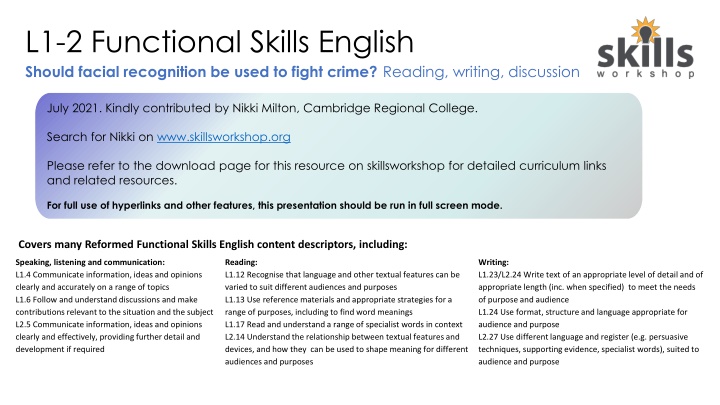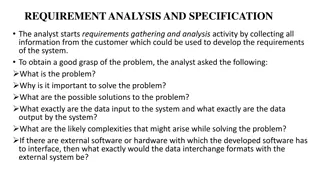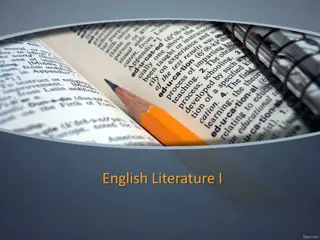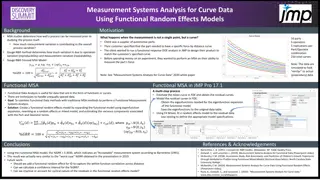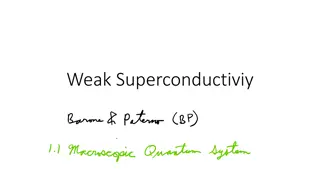L1-2 Functional Skills English
Automated facial recognition technology is utilized by law enforcement to identify suspects and missing persons. While it can enhance public safety, careful selection of solutions is crucial due to potential drawbacks. This text explores the process, benefits, and limitations of facial recognition in forensic science, highlighting its role in maintaining societal security.
Download Presentation

Please find below an Image/Link to download the presentation.
The content on the website is provided AS IS for your information and personal use only. It may not be sold, licensed, or shared on other websites without obtaining consent from the author.If you encounter any issues during the download, it is possible that the publisher has removed the file from their server.
You are allowed to download the files provided on this website for personal or commercial use, subject to the condition that they are used lawfully. All files are the property of their respective owners.
The content on the website is provided AS IS for your information and personal use only. It may not be sold, licensed, or shared on other websites without obtaining consent from the author.
E N D
Presentation Transcript
Description: swlogo L1-2 Functional Skills English Should facial recognition be used to fight crime? Reading, writing, discussion July 2021. Kindly contributed by Nikki Milton, Cambridge Regional College. Search for Nikki on www.skillsworkshop.org Please refer to the download page for this resource on skillsworkshop for detailed curriculum links and related resources. For full use of hyperlinks and other features, this presentation should be run in full screen mode. Covers many Reformed Functional Skills English content descriptors, including: Speaking, listening and communication: L1.4 Communicate information, ideas and opinions clearly and accurately on a range of topics L1.6 Follow and understand discussions and make contributions relevant to the situation and the subject L2.5 Communicate information, ideas and opinions clearly and effectively, providing further detail and development if required Reading: L1.12 Recognise that language and other textual features can be varied to suit different audiences and purposes L1.13 Use reference materials and appropriate strategies for a range of purposes, including to find word meanings L1.17 Read and understand a range of specialist words in context L2.14 Understand the relationship between textual features and devices, and how they can be used to shape meaning for different audiences and purposes Writing: L1.23/L2.24 Write text of an appropriate level of detail and of appropriate length (inc. when specified) to meet the needs of purpose and audience L1.24 Use format, structure and language appropriate for audience and purpose L2.27 Use different language and register (e.g. persuasive techniques, supporting evidence, specialist words), suited to audience and purpose
Should facial recognition be used to fight crime? What language features can you find in this text? Automated Facial Recognition in Forensic Science Automated Facial Recognition in Forensic Science Automated facial recognition is a method to identify or verify the identity of someone by using the unique characteristics of their face. The technology captures, analyses, and compares patterns from the facial details of a number of people. It can be used to verify identities in pictures, videos, or real-time. Facial recognition is used by law enforcement to look for suspects and missing people. It can help to find people who have committed crimes and lead to a safer society. However, it is not fool proof and may cause a unique set of problems, so careful selection of facial recognition solutions is important, especially in governmental settings. What layout (organisational) features can you find in this text? What are they used for? What is the purpose of this text? What questions do you have after reading this text? Key Vocabulary Facial recognition is used to identify a suspect. It can be completed by a person, artificial intelligence (AI), or both. When the work is completed through AI, the basic process usually involves the following steps: An image is captured The computer program takes information about the face and transforms it into digital information, such as measuring the space between eyes, the shape of the chin, and the length of the nose A special algorithm is used to compare the test face and others in a database The program determines if the face matches another one in the database verify unique characteristics analyses recognition fool proof artificial intelligence (AI) The data about a face is called face template and only includes certain details that can help people distinguish it from other faces. algorithm distinguish Source: https://www.technologynetworks.com/applied-sciences/articles/the-benefits-and-drawbacks-of-automated-facial-recognition-in-forensic-science- 341401#:~:text=Automated%20facial%20recognition%20is%20a%20method%20to%20identify,to%20verify%20identities%20in%20pictures%2C%20videos%2C%20or%20real-time.
Should facial recognition be used to fight crime? How How do law enforcement do law enforcement officers use facial recognition? officers use facial recognition? Compare a mugshot to other law enforcement databases to see if there s a match Identify people suspected of committing a crime Monitor people who may pose a threat to an organisation s security Stop people on the street to photograph them and check the image with their databases Identify terrorists Monitor people boarding planes Detect fraud and identity theft Locate missing children Discussion Point Discussion Point What is your viewpoint on using AI to profile people in public places? Key Vocabulary What do you think are the advantages and limitations of facial recognition? mugshot law enforcement databases Can you think of any bias that AI may have within the facial recognition program? terrorists Source: https://www.technologynetworks.com/applied-sciences/articles/the-benefits-and-drawbacks-of-automated-facial-recognition-in-forensic-science- 341401#:~:text=Automated%20facial%20recognition%20is%20a%20method%20to%20identify,to%20verify%20identities%20in%20pictures%2C%20videos%2C%20or%20real-time Video source: https://www.youtube.com/watch?v=qG4IaHgqH00
Should facial recognition be used to fight crime? Is facial recognition biased? Is facial recognition biased? Using the web, research bias in facial recognition algorithms. Write a report about the use of facial recognition to fight crime. In your report you should: Discuss the idea of facial recognition to fight crime Consider the advantages and limitations of AI (artificial intelligence) Explore facial recognition bias Conclude and make recommendations for the future of fighting crime. You should aim to write about 250 300 words. Some useful links: Key Vocabulary https://ipvm.com/reports/nist-bias-east-west bias https://www.abc.net.au/news/2020-02-04/fact-check-facial-recognition-darker- skin/11781192?nw=0 algorithms artificial intelligence https://www.nature.com/articles/d41586-020-03186-4
